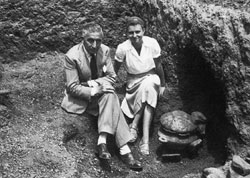
Mylai (Milazzo)
 Domenico Ryolo and Madeleine Cavalier on the excavation of the necropolis on the Isthmus of Milazzo in 1950
Domenico Ryolo and Madeleine Cavalier on the excavation of the necropolis on the Isthmus of Milazzo in 1950The concurrence of a series of particularly favourable geographic factors turned Milazzo into one of the more suitable sites for human settlement in antiquity. The Acropolis of Milazzo is now dominated by the Castle dating to the Hohenstaufen and Aragonese period and surrounded by imposing fortifications of the 16th and 17th century, which turned the city into one of the military bastions to secure Spain's military domination over Sicily. Milazzo was the site of important settlements at least since the Bronze Age. In the period of Greek colonization Mylai was perhaps founded not as an independent polis, but as a colony and maritime fortress of the state of Zankle-Messana, which used it to defend its possession of the rich agricultural plain and the harbour. Its foundation is placed in 716 BC.
The excavations conducted by L. Bernaḅ Brea and M. Cavalier in the city's burial sites were particularly important for the reconstruction of the complex development of the settlement pattern of Milazzo. They demonstrated that Milazzo was closely linked to the Aeolian Isles both from a cultural and an historical point of view. The Greek necropolis of the isthmus is situated in the area of the isthmus. It was superimposed over the earlier proto-Villanovan burial site. The huge and rich cemetery of Predio Caravello in the district of Sottocastello, to the north of the Rocca, is dated to the Milazzese period (middle Bronze Age). Some little pots in the Capo Graziano style, and remains of tombs disturbed by later inhumations, found in the area of Piazza Roma, demonstrate that the burial site must have already been formed during the 16th or 15th century BC. Sporadic traces of Ausonio I (1260-1125 BC) were found instead in the Borgo on the eastern slope of the Castle. Explorations recently conducted by the Soprintendenza of Messina (G.Tigano) have regarded not only the cemetery on the isthmus, but also the Bronze Age settlement site.
Bibliography:
- L. Bernabò Brea M. Cavalier, Mylai, Società di Storia Patria per la Sicilia Orientale, Serie III, Monografie archeologiche della Sicilia-II, Novara 1959, pp. 1-136.